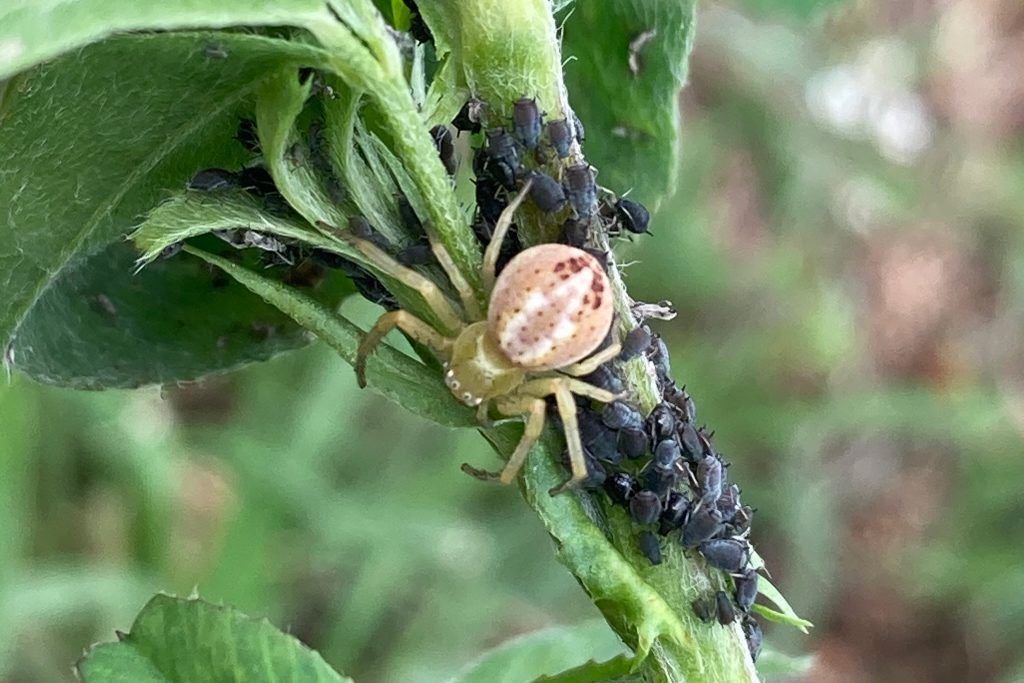We have had reports of moderate numbers of cowpea aphid (Aphis craccivora) in southern NSW in pastures and legume crops. Although not reaching damaging numbers like last year, there are a few factors, including photosensitivity and insecticide efficacy, which need to be taken into account when managing these pests.
Cowpea aphid identification
The cowpea aphid is a widespread and relatively common pest of legume and pulse crops (including field peas, lupins, lentils, faba beans, lucerne, clover and medics) throughout Australia.
The fact that they can attack a wide range of plants means there is some cross over in hosts with several other crop aphids – green peach aphid, pea aphid, bluegreen aphid and spotted alfalfa aphid. However, identifying cowpea aphid is relatively easy because it is the only species out of these five that is dark grey to black, which makes them stand out against the green foliage.

Unlike some other aphids, cowpea aphid can also tolerate warm, dry weather conditions. They are most prominent in spring but are also active during autumn and persist (albeit in low numbers) through winter.
For more information on cowpea aphid, visit our PestNote.
Additional impacts of cowpea aphids
In addition to affecting crops through direct feeding, cowpea aphids are believed to be responsible for photosensitisation (inflammation of the skin & eyes) when infected pastures are grazed by livestock. There were considerable issues with photosensitisation across several regions of NSW in 2020. We have had reports of this occurring in sheep again this year. To date, the extent of photosensitisation issues appear to be less than observed in 2020. It is recommended that growers remain vigilant over the coming months as cowpea aphid numbers increase with warmer conditions.
Photosensitisation is thought to occur as a result of photodynamic fluorescent pigments in the aphid, but the exact cause is unknown. If you are concerned about photosensitisation of livestock feeding on crops and pastures infested with cowpea aphid, seek veterinary assistance for correct diagnosis and management of the condition.
The cowpea aphid is also a vector of several crop diseases. Aphids spread viruses between plants by feeding and probing as they move between plants and paddocks. Cowpea aphids transmit important viruses including cucumber mosaic virus (CMV), bean yellow mosaic virus (BYMV), alfalfa mosaic virus (AMV) and pea seed-borne mosaic virus (PsbMV).
Insecticide resistance risk
The cowpea aphid has evolved insecticide resistance to multiple insecticides outside Australia and was recently identified as a high-risk species in Australian cropping systems.
A recent study conducted by Cesar Australia in collaboration with the University of Melbourne and the CSIRO tested the sensitivity of cowpea aphid populations against insecticides from four different Mode of Action groups – organophosphates, synthetic pyrethroids, carbamates and neonicotinoids.
Small differences in sensitivity were detected between some populations against pirimicarb (a carbamate) and dimethoate (an organophosphate). Nonetheless, the field rate of these insecticides was effective at controlling all cowpea aphid populations.
This research suggests there is unlikely to be field resistance in populations of cowpea aphid in Australia at this time. This is good news and means we can be confident that the chemical options currently available will be effective. However, as is evidenced by overseas experiences, the cowpea aphid is at risk of evolving resistance, so caution should be used when choosing management options.
Cowpea aphid management
Regularly monitor vulnerable crops during bud formation to late flowering for cowpea aphids. When weighing up whether to spray or not, remember that under good growing conditions, crop and pasture plants are better able to compensate for direct feeding damage caused by cowpea aphids.
Economic thresholds for cowpea aphids are available for several pulse crops. Further information can be found by visiting our PestNote.
If spraying is warranted, we recommend using selective insecticides over broad-spectrum insecticides to preserve beneficial insects (and spiders!) – which play a very important role in helping to suppress spring populations of aphids.

Additionally, due to the risk of resistance evolution, it is recommended that when using insecticides to control cowpea aphids, spray applications are rotated between chemical products from different Mode of Action groups.
Acknowledgements
Thank you to Joe Powells (South East Local Land Services) and Frank McRae (AusWest Seeds) for reports, and Paul Umina for contributions to this article.
Cover image: Wingless cowpea aphid adult and nymph. Photo by Andrew Weeks, Cesar Australia





